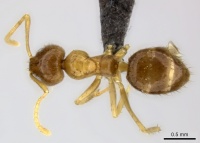Nylanderia usambarica
| Nylanderia usambarica | |
|---|---|

| |
| Scientific classification | |
| Kingdom: | Animalia |
| Phylum: | Arthropoda |
| Class: | Insecta |
| Order: | Hymenoptera |
| Family: | Formicidae |
| Subfamily: | Formicinae |
| Tribe: | Lasiini |
| Genus: | Nylanderia |
| Species: | N. usambarica |
| Binomial name | |
| Nylanderia usambarica LaPolla, Hawkes & Fisher, 2011 | |
Known only from the type locality, specimens were found in a pitfall trap in primary forest.
Identification
LaPolla et al. (2011) - Abundant macrosetae of varying lengths on pronotum (PSC = 10–22); macrosetae on head, mesosoma and legs dark and contrasting strongly with the much lighter cuticle; propodeal dorsum not domed.
Compare with: Nylanderia luteafra, Nylanderia natalensis and Nylanderia jaegerskioeldi
Most likely to be confused with callows of N. natalensis and N. jaegerskioeldi but it can be separated from these by the higher PMC and the distinctly indented posterior margin of the head. While the color of N. usambarica is similar to that of N. luteafra, these species can be readily distinguished by the strongly domed propodeal profile of the latter. N. usambarica has the highest PMC of any Afrotropical Nylanderia species currently known.
Keys including this Species
Distribution
Latitudinal Distribution Pattern
Latitudinal Range: -4.91456° to -4.91456°.
| North Temperate |
North Subtropical |
Tropical | South Subtropical |
South Temperate |
- Source: AntMaps
Distribution based on Regional Taxon Lists
Afrotropical Region: United Republic of Tanzania.
Distribution based on AntMaps
Distribution based on AntWeb specimens
Check data from AntWeb
Countries Occupied
| Number of countries occupied by this species based on AntWiki Regional Taxon Lists. In general, fewer countries occupied indicates a narrower range, while more countries indicates a more widespread species. |

|
Estimated Abundance
| Relative abundance based on number of AntMaps records per species (this species within the purple bar). Fewer records (to the left) indicates a less abundant/encountered species while more records (to the right) indicates more abundant/encountered species. |

|
Biology
Castes
The queen and male castes are currently unknown for this species.
Nomenclature
The following information is derived from Barry Bolton's Online Catalogue of the Ants of the World.
- usambarica. Nylanderia usambarica LaPolla, Hawkes & Fisher, 2011: 24, figs. 61-63, 86 (w.) TANZANIA.
Description
Measurements (n = 6): TL: 2.3–2.8; HW: 0.55–0.64; HL: 0.67–0.74; EL: 0.14–0.16; SL: 0.73–0.80; PW: 0.41–0.47; WL: 0.77–0.90; GL: 0.90–1.4
Indices: CI: 82–87; REL: 20–22; SI: 123–133
Overall golden yellow-brown, with lighter golden yellow antennae and legs; head and gaster slightly darker than mesosoma; legs nearly uniform in color, with coxae and trochanters slightly lighter than the remaining segments; cuticle smooth and shining but with faint, almost effaced shagreening, which is more noticeable on lateral propodeum and gaster; macrosetae on head, mesosoma and legs dark and contrasting strongly with the much lighter cuticle; macrosetae on scapes lighter. Head dorsally with abundant macrosetae and a layer of fine pubescence which becomes sparse anterolaterally; posterior margin distinctly emarginate medially; posterolateral corners strongly rounded and sides convex, giving the head a distinctly rounded appearance in full face view; scapes surpass posterior margin of head by about the length of the first 3–4 funicular segments; scapes with scattered erect macrosetae and a dense layer of pubescence (SMC = 24–32). Mesosoma with erect macrosetae of varying lengths on pronotum and mesonotum (PMC = 10–22; MMC = 3–4); pubescence sparse and scattered on pronotum and mesonotum; metanotal area compact; dorsal face of propodeum short and low (lower than mesonotum), rounding broadly into the longer declivitous face; propodeal dorsum and sides with pubescence; declivity smooth and shining with no pubescence. Gaster with erect macrosetae and a layer of sparse pubescence.
Type Material
Holotype worker, TANZANIA: Tanga Region, Nilo Forest Reserve, 1006 m, 4.91456 S, 38.67712 E, 1–4.ix.2005, CEPF-4.4-F24, (P. Hawkes, J. Makwati, R. Mtana) (South African Museum) (SAM-HYM-C020684); 11 paratype workers, 9 same label data as holotype, 1 same data but CEPF-4.2-F35, 1 same data but CEPF-4.4-F33 (National Museum of Natural History, California Academy of Sciences, NMKE, SAMC)
Etymology
The specific epithet usambarica refers to the East Usambara mountain range in which the type series was collected.
References
- LaPolla, J.S., Hawkes, P.G. & Fisher, B.L. (2011) Monograph of Nylanderia (Hymenoptera: Formicidae) of the World, Part I: Nylanderia in the Afrotropics. Zootaxa 3110: 10–36.

